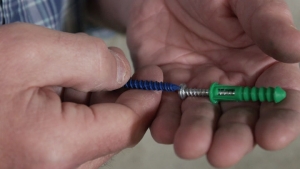How to Make a Sandpaper Cutter
Make Your Own Sandpaper Cutter
Hand-held finishing sanders use a quarter sheet of sandpaper. Each new sheet of sandpaper has to be divided into four equal pieces. Using a straight edge to mark it and scissors or a utility knife to cut it will work--if you do not mind dulling the scissors and the knife in short order. Why not make a dedicated sandpaper cutter that leaves the edge on your scissors while making the sandpaper cutting easy? Here are the steps to construct and use this handy tool.
- Attach a thin strip of wood flush along one edge of a piece of 3/4-inch plywood base that is approximately a 12 x 18-inch rectangle. Your dimensions can vary as long as it is big enough to accommodate the sheet of sandpaper. Make it the same length as the base and secure the strip with a pneumatic brad gun.
- Attach the second strip of wood exactly 1-inch wide to the first strip (not to the base) with a piano hinge and small screws after butting their two edges together. We used a piano hinge, but any small hinges will serve. Attach the hinge so that the small strip will hinge back on the larger strip.
- Fold a piece of sandpaper in half lengthwise to determine how far away from the narrow hinged strip of wood to place the cutting blade.
- Lay the folded paper on the plywood base, butted against the hinged strip, and trace the other edge with a pencil.
- Lay a new hacksaw blade along the traced line on the same side as the hinged strip and trace the holes at either end for screw holes. You can use an old blade for the cutter, but a new sharp blade is not very expensive and will cut better. Pre-drill the small screw holes and lay a small washer over each.
- Insert the screw through a washer and through the hacksaw blade and then fit the screw into the washer/hole on the plywood base. Be sure to position the sharp edge of the blade away from the hinged strips. Tighten the screw in the plywood base. Repeat for the second screw.
- Hinge out the narrow strip and insert the long edge of a full sheet of sandpaper under the blade, butting it against the wooden strip. Tear upwards against the blade to cut the sandpaper lengthwise.
- Insert the narrow end of the half-sheet of sandpaper under the blade after folding back the narrow hinged strip. Pull up against the blade to cut it.
Blog Articles
Have You Heard of Landscape Glue?
You love the rustic charm of a gravel walkway, but the constant scattering of stones across your lawn and patio can be a real headache. Whether it’s from pets, lawn mowers, or just foot traffic, it seems impossible to keep those stones in place. Sound familiar? Well, Brian shows us a simple DIY method using landscape glue to keep your gravel path looking pristine and, more importantly, in place.
How to Remove Candle Wax Drips: Two Effective Methods
Candles create a warm and inviting atmosphere, but those pesky wax drips can be a real headache. Luckily, Brian shows us a couple of effective methods to tackle this issue, and they involve two very different temperatures: hot and cold. Here, we'll explore two effective methods: one using cold and the other using heat.
Guide to Hanging on Masonry Walls
Ever wondered how to hang that picture frame or shelf on a brick or concrete wall? It can seem daunting, but with the right tools and techniques, it's a straightforward DIY project. This guide breaks down two common methods: using concrete screws and using anchors, making it easy for you to tackle your next hanging project.





